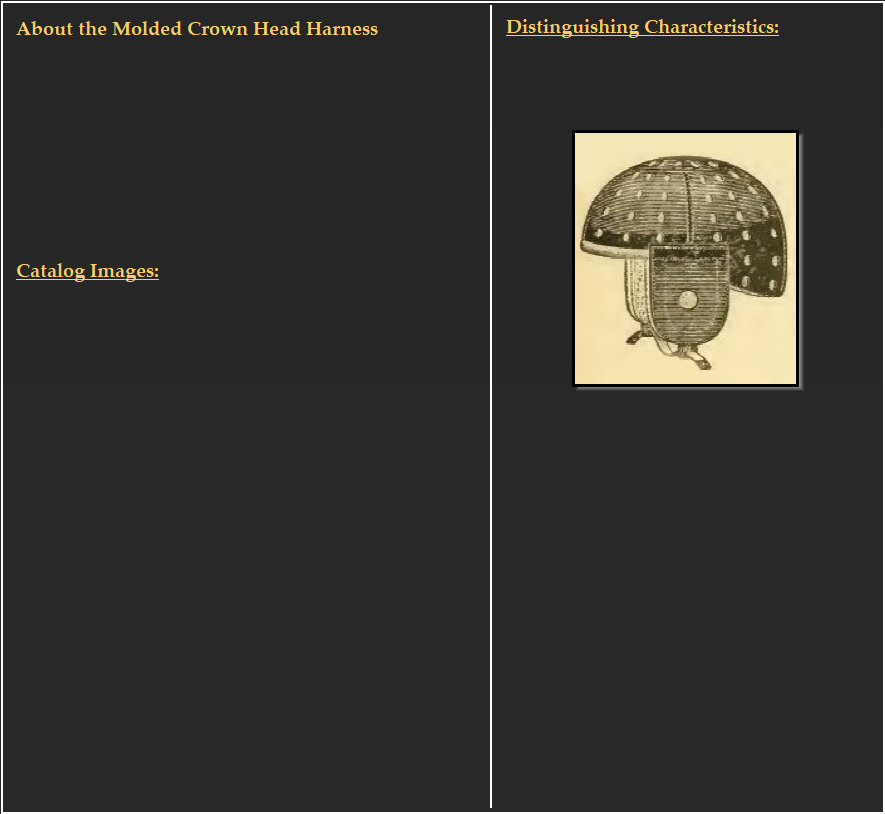






Questions or comments? Please email me at:
My January 2020 Artifact of the Month is an unusual, circa 1900 molded crown head harness with adjustable ear protectors by an unknown manufacturer. The only known example of this style, the harness possesses two large ear protectors with oversized wool padding that are not connected to the rigid leather crown. Instead, the ear protectors are attached to one other with leather and elastic straps that run through slots cut into the center of the crown and retainers attached to either side. The design allowed the ear protectors to be adjusted up and down so that the harness could be fitted to a range of head sizes.
Because of its unique design, the possibility exists that the harness could have been utilized for other purposes, such as a military, automotive, or motorcycle helmet. However, there are several features that strongly suggest its use in football. First, the most substantial padding on the harness is on the ear protectors, which is consistent with the focus of most turn-of-the-century football head harnesses. While prioritizing ear protection, the ear flap design also incorporated large center holes that would have permitted a player to hear signals called on the field. Neither of these features are prevalent in early aviation, tanker, or automotive helmet designs.
Because of its unique design, the possibility exists that the harness could have been utilized for other purposes, such as a military, automotive, or motorcycle helmet. However, there are several features that strongly suggest its use in football. First, the most substantial padding on the harness is on the ear protectors, which is consistent with the focus of most turn-of-the-century football head harnesses. While prioritizing ear protection, the ear flap design also incorporated large center holes that would have permitted a player to hear signals called on the field. Neither of these features are prevalent in early aviation, tanker, or automotive helmet designs.


The Molded Crown Head Harness was similar in design to the raincap style, but utilized a more rigid, bowl-shaped molded leather crown. The process for molding leather involves immersing the material in water, stretching it over a mold form, and allowing it to dry and stiffen in the shape of the mold. The resulting molded crown head harnesses were stiffer than raincap models, but less rigid than banned sole leather models. Molded crown head harnesses possess independent ear flaps that are sewn or riveted to the body, and cotton or wool padding on the interior of the helmet.
January 2020
c. 1900 Molded Head Harness with Adjustable Ear Flaps
1915 D&M No. 32B
1922 D&M No. 10H
1909 Spalding No. A
1921 Reach No. 1A
December 2015
c. 1910 All-Leather
Molded Crown Head Harness

AntiqueFootball Artifact of the Month
1902 Victor
No. 540
Molded Crown
Example
Ear Protector Comparison
Identical Stitch Pattern
Identical Chin Strap Tab
Width & Material
R1
R2
R1
R2
c. 1900 8-Strap Head Harness Example
Molded Crown
Example
Ear Padding Comparison
Two Piece Wool Padding



Construction Comparison
1907 P. Goldsmith's Sons No. 48
Molded Crown Example
Ventilated Crown



Second, many techniques used to manufacture the harness are similar to other turn-of-the-century football harness examples and, in some cases, appear to be precursors of future designs. In 1907, P. Goldsmith's Sons introduced the No. 48 head harness which featured a similar ear protector retainer strap to our molded crown example. It is possible that the harness may be an earlier version of Goldsmith's design. Another possibility is that the harness is an early Victor Sporting Goods model based on ear protector similarities. The construction of the ear protectors and padding is identical to Victor's No. 540, produced between 1900 and 1905. Unlike their contemporaries that used an elastic chinstrap, the No. 540 and our example both utilized a 3" long x 1" wide leather chinstrap tab that extended downward below the ear protector. The leather tabs were then tightened below the chin using an elastic strap.
Finally, the two piece wool ear protector padding, the diagonally sewn cotton stitching connecting the padding to the ear protector, and the elastic strapping used to connect the two ear protectors are all consistent with construction techniques used on circa 1900 head harnesses by multiple athletic goods manufacturers. Given these similarities in design, materials, and construction techniques, I believe that this example is a previously undocumented football head harness style. If you have any photographic or catalog documentation of this style, please let us know!
